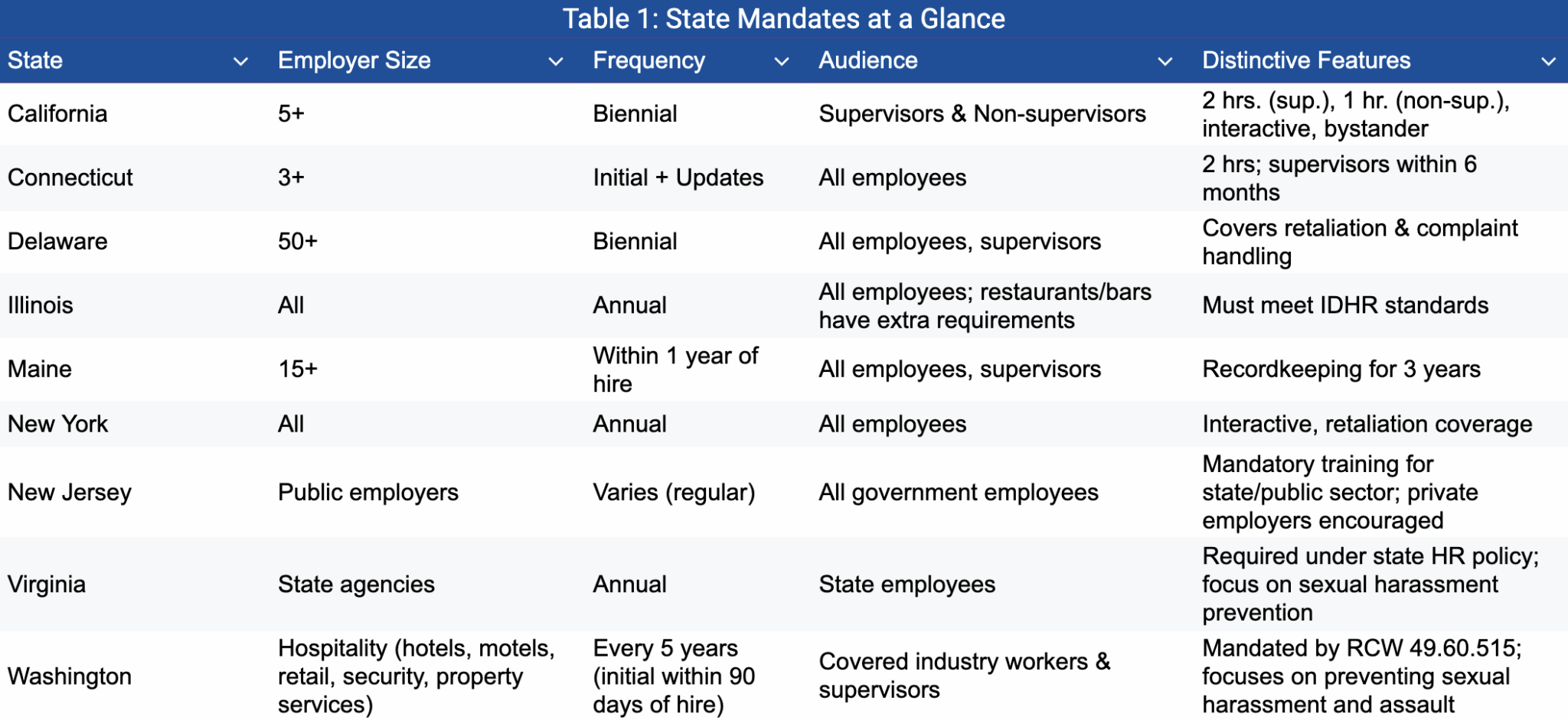
Workplace harassment remains one of the most pressing compliance and cultural challenges for employers in 2025. Despite decades of awareness, the Equal Employment Opportunity Commission (EEOC) still reports thousands of harassment claims each year, with significant financial and reputational costs for organizations that fall short in prevention. New legislation across several states, coupled with heightened employee expectations for safe and respectful workplaces, makes anti-harassment training not just a compliance requirement but a cornerstone of effective organizational leadership.
At its core, anti-harassment training equips employees, managers, and executives with the tools to identify, prevent, and respond to inappropriate conduct. It goes beyond fulfilling legal mandates, when effectively presented, it creates a culture of respect, inclusivity, and accountability. For organizations operating across multiple states, the complexity grows; each jurisdiction has its own rules on who must be trained, how often, and in what format. California, New York, and Illinois, for example, have some of the strictest mandates, while other states only provide recommendations. Understanding these differences is critical for compliance officers, HR leaders, and business owners.
This guide offers a comprehensive roadmap for HR professionals, business owners, managers, and compliance teams seeking to navigate the intricate legal landscape, implement meaningful anti-harassment workplace training, and avoid the pitfalls of “check-the-box” compliance. Along the way, you will find practical checklists, real-world case studies, and a cost–benefit analysis of different training models. Whether you are building a program for a small business or refining a multi-state compliance strategy, this article provides actionable insights you can apply immediately.
What is Anti-Harassment Training?
Anti-harassment training refers to structured educational programs designed to prevent workplace harassment in all its forms. While the term is often associated primarily with sexual harassment, comprehensive training extends much further, covering harassment based on race, religion, disability, gender, sexual orientation, age, and other protected characteristics.
The EEOC defines harassment as unwelcome conduct based on a protected class that creates a hostile, intimidating, or offensive work environment, or when enduring such conduct becomes a condition of continued employment. Effective training ensures employees understand these boundaries and gives them the skills to recognize subtle and overt harassment alike.
Checklist: Core Elements of Anti-Harassment Training
✔ Clear definitions of harassment (with real-world examples)
✔ Distinctions between harassment, discrimination, and bullying
✔ Explanation of employees’ and managers’ legal responsibilities
✔ Reporting channels (anonymous hotlines, HR contacts, escalation paths)
✔ Case studies or interactive role-play scenarios
✔ Emphasis on respect, inclusion, and bystander intervention
✔ Documentation and certification procedures
Types of Harassment Covered
Modern anti-harassment workplace training addresses multiple categories of misconduct, including:
- Sexual harassment: Unwelcome sexual advances, requests for favors, inappropriate jokes, or physical conduct.
- Racial and ethnic harassment: Derogatory remarks, stereotyping, or exclusion based on race, color, or national origin.
- Religious harassment: Mockery, exclusion, or pressure to participate in practices outside an employee’s faith.
- Disability-based harassment: Derogatory treatment or failure to accommodate.
- Age-related harassment: Negative stereotypes or exclusion of older workers.
By educating employees about these categories, organizations create awareness that harassment is not limited to overt misconduct but includes micro-aggressions and systemic behaviors that can erode workplace trust.
Harassment vs. Discrimination
A frequent point of confusion is the difference between harassment and discrimination. Discrimination generally refers to adverse employment actions, such as firing, failing to promote, or unequal pay, based on legally protected characteristics. Harassment, meanwhile, refers to conduct that creates a hostile or abusive work environment. Both are unlawful under Title VII of the Civil Rights Act of 1964 and related laws, but training must make this distinction clear so employees understand how their behaviors or managerial decisions may cross legal boundaries.
Example: If a 55-year-old employee is denied a promotion solely due to age, that is discrimination. If colleagues repeatedly mock the same employee with “retirement jokes,” that is harassment.
Legal Foundations
Federal law, particularly Title VII, provides the baseline legal framework. The EEOC enforces these protections, and landmark Supreme Court cases (such as Faragher v. City of Boca Raton and Burlington Industries, Inc. v. Ellerth) have established employer liability standards for harassment. However, state-level laws frequently impose stricter requirements, especially regarding mandatory training.
Employers should note that federal law does not currently mandate training across the board, instead, the obligation comes from state and local statutes, as well as from the expectation that training is a proactive measure to prevent liability. That is why understanding anti-harassment training requirements by state is so critical.
Benefits for Organizations
Beyond compliance, robust training programs deliver measurable organizational benefits:
- Risk reduction: Reduces the likelihood of lawsuits, penalties, and EEOC complaints.
- Employee engagement: Demonstrates a commitment to fairness and respect, boosting morale and retention.
- Culture building: Creates a safer, more inclusive workplace that attracts top talent.
- Reputation management: Avoids the brand damage that comes with high-profile harassment cases.
Example: Consider the case of a mid-sized hospitality company in New York. After implementing interactive annual anti-harassment training sessions, employee complaints dropped by 45% within two years, while internal surveys showed significant increases in employee trust in HR. This illustrates the dual advantage: legal compliance paired with meaningful cultural improvement.
In short, anti-harassment training is not just a regulatory checkbox but a proactive strategy for strengthening organizational health, protecting employees, and ensuring sustainable growth.
Current Legal Landscape
The foundation of workplace anti-harassment law in the United States rests on Title VII of the Civil Rights Act of 1964, which prohibits employment discrimination based on race, color, religion, sex, or national origin. Under Title VII, harassment is recognized as a form of discrimination when it creates a hostile work environment or results in an adverse employment decision. While Title VII does not explicitly require employers to provide anti-harassment training, federal enforcement practices make clear that such training is considered a critical element of compliance.
The Equal Employment Opportunity Commission (EEOC) is the primary federal agency enforcing anti-harassment provisions. The EEOC has issued guidance repeatedly emphasizing the value of preventive training. In particular, its 2016 Select Task Force on the Study of Harassment in the Workplace concluded that training is one of the most effective tools to reduce incidents of harassment when it is well designed, interactive, and leadership-supported.
Court decisions have also clarified employers’ responsibilities. In Faragher v. City of Boca Raton (1998) and Burlington Industries, Inc. v. Ellerth (1998), the U.S. Supreme Court established that employers may be held vicariously liable for supervisory harassment but may assert an affirmative defense if they can demonstrate:
- They exercised reasonable care to prevent and promptly correct harassing behavior; and
- The employee unreasonably failed to take advantage of preventive or corrective opportunities provided by the employer.
Documented anti-harassment training programs are often cited as evidence of “reasonable care,” making them essential to mitigating liability. In practice, companies without training programs face a much higher risk of failing to meet the affirmative defense standard.
The federal framework has also been shaped by EEOC settlements. For example, in a 2020 case against a national retail chain, the EEOC required the company to implement a comprehensive anti-harassment training program as part of a multimillion-dollar consent decree. This illustrates the Commission’s reliance on training not just as a best practice but as a mandated remedy for proven violations.
In addition to Title VII, other federal statutes and regulations address harassment in specific contexts. These include:
- Title IX of the Education Amendments of 1972, covering educational institutions.
- Section 1557 of the Affordable Care Act, covering harassment in healthcare settings.
- State equivalents of Title VII, which are often interpreted in harmony with federal law but may expand protections further.
Despite these layers, it is important to underscore that federal law does not mandate training nationwide. Rather, it establishes a compliance environment in which training is strongly encouraged, frequently required as part of settlement agreements, and treated by courts as evidence of employer diligence.
The legal landscape is further complicated by evolving definitions of harassment. Recent EEOC guidance emphasizes not only sexual harassment but also harassment based on sexual orientation, gender, and other protected characteristics. Employers must ensure training content reflects these broader protections, particularly following the Supreme Court’s decision in Bostock v. Clayton County (2020), which confirmed that Title VII’s protections extend to sexual orientation and gender identity.
Taken together, the current federal landscape presents a paradox: training is not federally mandated, yet it is functionally indispensable. Employers who provide comprehensive, interactive training aligned with EEOC guidance are better positioned to prevent harassment, defend against claims, and demonstrate a culture of compliance.
Anti-Harassment Training Requirements by State
While federal law (Title VII of the Civil Rights Act of 1964) provides the foundation for workplace harassment protections, the true complexity of compliance emerges at the state and municipal levels. Employers must navigate a patchwork of training mandates that vary by jurisdiction in terms of frequency, scope, audience, and required content. Understanding and meeting these obligations is critical not only for avoiding legal liability but also for fostering a workplace culture of respect and accountability.
State Mandates: A Patchwork of Requirements
Although most states strongly encourage anti-harassment training, only a subset mandate it by law. The following states have codified explicit requirements, each reflecting unique legislative priorities and histories of enforcement.
California (FEHA, AB 1825, SB 1343)
- Employers with 5+ employees must provide training every two years.
- Supervisors: 2 hours; Non-supervisors: 1 hour.
- Content must include examples, interactive components, and bystander intervention.
- The California Department of Fair Employment and Housing (DFEH) can impose penalties for noncompliance.
Connecticut (Public Act 19-16)
- Applies to all employers with 3+ employees.
- Requires 2 hours of training for supervisors and non-supervisors, to be completed within six months of hire.
- Employers must update training periodically, especially when laws change.
Delaware (HB 360)
- Employers with 50+ employees must provide training to all employees every 2 years.
- Supervisors receive additional instruction on preventing and responding to complaints.
- Training must cover retaliation protections and complaint-handling processes.
Illinois (Workplace Transparency Act, 2019)
- Applies to all employers regardless of size.
- Requires annual training, which must meet or exceed the Illinois Department of Human Rights (IDHR) model program.
- Restaurants and bars must provide industry-specific training on harassment prevention.
Maine (26 M.R.S. §807)
- Employers with 15+ employees must train all employees within one year of hire.
- Supervisors must receive additional training on responsibilities and complaint handling.
- Employers must keep training records for at least 3 years.
New York State (NYS Human Rights Law, 2018)
- Applies to all employers, regardless of size.
- Requires annual training for all employees.
- Training must be interactive, cover retaliation, and use examples of unlawful conduct.
- Employers must maintain records and issue training completion acknowledgments.
New Jersey
- While New Jersey law does not currently mandate harassment prevention training for all private employers, it does require such training for all state government and many public-sector employees. The state’s Office of Equal Employment Opportunity provides model programs, and public agencies must ensure employees complete training on a regular cycle.
- For private employers, training is strongly encouraged, particularly given the state’s robust anti-discrimination law (the New Jersey Law Against Discrimination, or LAD). Courts have held that failure to provide training can undermine an employer’s legal defense in harassment lawsuits.
- As a result, many private employers in New Jersey adopt regular training as a risk management tool, even in the absence of a strict mandate.
Virginia
- The Commonwealth requires all state agencies to conduct annual harassment prevention training for their employees, overseen by the Virginia Department of Human Resource Management. This training covers sexual harassment, workplace civility, and reporting obligations.
- Private-sector employers are not mandated by statute, but, as in New Jersey, case law and EEOC expectations make training a best practice.
- Virginia’s emphasis on annual training for public employees demonstrates a state-level recognition of training as a core prevention tool, and many private employers follow suit voluntarily to reduce liability.
Washington: (RCW 49.60.515)
- Washington’s law imposes one of the more industry-specific mandates in the nation. Employers in the hospitality sector (hotels, motels), retail establishments, security firms, and property services must provide sexual harassment prevention training to employees within 90 days of hire, with refreshers required at least every five years.
- The training must include strategies for preventing sexual assault and harassment, bystander intervention, and reporting mechanisms. This law arose from widespread reports of harassment in hotels and service industries, where vulnerable workers (such as housekeepers and security staff) often operate in isolated environments.
- Washington’s approach highlights how training mandates can be targeted to high-risk industries, rather than broad employer categories.
Local Ordinances: Cities Raising the Bar
In addition to state laws, several cities and counties have enacted their own ordinances, often imposing stricter requirements.
New York City (Stop Sexual Harassment in NYC Act, 2018)
- Employers with 15+ employees must provide annual interactive training.
- Must cover sexual harassment, bystander intervention, and complaint processes.
- Employers must maintain signed acknowledgments for at least 3 years.
Chicago (Human Rights Ordinance, 2022 amendments)
- Employers must provide annual training:
- One hour for all employees.
- Two hours for supervisors.
- One hour of bystander intervention training.
- Employers must keep written records of compliance.
Westchester County, NY (2019 law)
- Mirrors New York State’s requirements but emphasizes employer responsibility to provide written anti-harassment policies.
Washington, D.C. (Tipped Wage Workers Fairness Amendment Act, 2018)
Employers of tipped workers (restaurants, bars) must provide anti-harassment training every 2 years, tailored to the hospitality industry.

Compliance Challenges for Employers
- Multi-State Operations
Employers with a distributed workforce often face conflicting requirements. Best practice is to adopt the strictest jurisdiction’s standard across the organization. - Remote/Hybrid Workforce
Training delivery must adapt to online formats while preserving interactivity. Employers should use learning management systems (LMS) that allow role-playing scenarios, quizzes, and breakout discussions. - Language Access
Several jurisdictions (NY, CA) require training in employees’ primary languages. Employers must translate materials and ensure facilitators can answer questions across linguistic barriers. - Documentation and Tracking
Recordkeeping is a recurring requirement. Employers should:- Maintain sign-in sheets or digital completions.
- Keep acknowledgments of training received.
- Store records for at least three years (or longer as best practice).
Compliance Checklist for HR and Compliance Officers
☐ Identify all jurisdictions where employees work.
☐ Review federal, state, and local training mandates.
☐ Develop or adopt training programs that meet or exceed the strictest requirements.
☐ Translate training materials as needed.
☐ Ensure interactivity (role-play, quizzes, live Q&A).
☐ Train supervisors separately with additional responsibilities.
☐ Maintain documentation: sign-ins, certificates, acknowledgments.
☐ Schedule regular refreshers and track completion dates.
☐ Audit program effectiveness annually.
Case Studies
Case Study 1: The Cost of Noncompliance
A mid-sized hospitality company in Chicago failed to provide the city-mandated bystander intervention training. Following an employee complaint, the Chicago Commission on Human Relations imposed fines and required the employer to implement an enhanced training program at its own expense. The costs of legal defense, penalties, and reputational damage far exceeded the investment that would have been required for compliance.
Case Study 2: Training as a Culture Builder
A New York-based technology firm proactively implemented interactive, scenario-driven training that went beyond the state’s minimum requirements. The company saw a 40% reduction in harassment complaints over three years and a measurable increase in employee engagement scores. By embedding anti-harassment training into onboarding and leadership development, the firm built a reputation as an employer of choice.
Forward-Looking Commentary
The trajectory of workplace law suggests that anti-harassment training mandates will only expand. Pending bills in Massachusetts, New Jersey, and Washington State would require annual training for most employers. At the federal level, the BE HEARD Act, though not yet passed, signals congressional interest in nationwide standards.
Industry-specific regulations are also on the horizon. The hospitality, healthcare, and public sector workforces are particularly targeted due to high complaint rates. Employers should anticipate new requirements that:
- Expand training to independent contractors and interns.
- Mandate annual training in more states.
- Require integration of related topics such as bystander intervention.
Forward-thinking employers are preparing by adopting robust, LMS-supported training systems that allow them to scale quickly and prove compliance across jurisdictions.
Conclusion about individual state requirements
Anti-harassment training requirements present a complex and evolving compliance challenge. Employers who treat training as a minimum legal obligation risk fines, lawsuits, and reputational harm. Those who embrace training as a cultural cornerstone not only reduce liability but also gain competitive advantages in recruitment, retention, and employee morale. With state and local governments continuing to raise the bar, and federal action likely on the horizon, employers are best served by adopting the strictest standards, documenting diligently, and building training into the fabric of workplace life.
What Should Anti-Harassment Training Include?
Effective anti-harassment training must balance legal compliance with practical workplace impact. While federal law under Title VII of the Civil Rights Act and EEOC guidance establishes broad standards, state mandates and best practices provide the structure for what must be included. At its core, training should equip employees and managers with the knowledge and skills to recognize, prevent, and address harassment in all its forms.
Core Content Requirements by Law
Most state laws and EEOC guidance specify that training must include:
- A clear definition of harassment, including sexual harassment and harassment based on race, religion, disability, age, sexual orientation, and gender identity.
- Examples of prohibited conduct, drawn from real workplace scenarios.
- An explanation of employees’ rights under the law and employer obligations to maintain a harassment-free environment.
- Detailed reporting procedures, including multiple avenues for making a complaint.
- Prohibitions against retaliation, with assurances of protection for those who report.
Beyond Minimum Compliance: Best Practices
Compliance is the floor, not the ceiling. Best-in-class training goes further by:
- Addressing workplace culture and respect.
- Teaching bystander intervention strategies, empowering employees to speak up.
- Incorporating intersectional perspectives, showing how different identities may experience harassment differently.
- Including content on microaggressions and subtle forms of misconduct that, if unchecked, can escalate.
Training Formats: Online vs. In-Person
Employers have flexibility in delivery, but each format has strengths:
- Online training offers scalability, consistent messaging, and accessibility for remote or distributed teams.
- In-person sessions allow for richer discussion, role-play, and nuanced Q&A.
- Hybrid approaches often combine both: self-paced online modules supplemented with live workshops.
Interactive Elements and Scenarios
The EEOC stresses that training must be interactive to be effective. Examples include:
- Role-play exercises for managers on handling complaints.
- Group discussions around “gray area” scenarios.
- Anonymous polling and quizzes to encourage engagement.
- Video dramatizations followed by guided debriefs.
Documentation Requirements
Training must be documented to demonstrate compliance. Employers should:
- Record attendance and completion.
- Archive training materials.
- Keep signed acknowledgments.
- Track completion dates for scheduling refreshers.
These records can serve as evidence in defending against EEOC charges or lawsuits.
Certification Processes
Many employers provide employees with a certificate of completion after training. Certification:
- Signals accountability to employees.
- Provides proof to regulators or courts.
- Helps HR track compliance at the individual level.
Ultimately, comprehensive anti-harassment training must not only satisfy statutory mandates but also foster a respectful, inclusive culture. Employers who go beyond compliance create workplaces where harassment is less likely to occur and more likely to be addressed effectively.
Training Frequency and Implementation
Training loses its effectiveness if it is treated as a one-time exercise. Both laws and best practices emphasize that training should be ongoing and refreshed regularly.
How Often Training Is Required by State
States vary widely:
- California and Connecticut: Supervisors must be retrained every two years.
- New York and Illinois: Training must occur annually.
- Delaware and Maine: Biennial refreshers are required.
Employers must align their schedules with the strictest mandate applicable to their operations.
New Employee Training Timelines
Some states set specific deadlines:
- California requires training within six months of hire or promotion to supervisor.
- Connecticut mandates that new employees must be trained within six months of starting.
- Maine requires training within one year of hire for employees in workplaces with 15 or more workers.
Onboarding is the ideal time to introduce company policies and expectations, ensuring new employees start with clarity.
Refresher Training Schedules
Even in states without explicit requirements, employers should set refreshers every 12–24 months. Short “micro-trainings” delivered quarterly or semi-annually can reinforce lessons without disrupting workflow.
Record-Keeping Requirements
Employers must maintain detailed records of training, often for several years. These include:
- Rosters of attendees.
- Dates of completion.
- Copies of training content.
- Certificates or acknowledgments of participation.
Strong record keeping not only ensures compliance but also protects organizations in the event of claims or audits.
By embedding training into onboarding, providing regular refreshers, and keeping accurate records, organizations demonstrate their commitment to maintaining a respectful workplace and mitigating legal risks.
Choosing the Right Training Program
Selecting the right program is crucial. Employers must balance compliance, cost, accessibility, and cultural fit to ensure the program is both effective and sustainable.
Evaluation Criteria for Training Providers
A strong provider should demonstrate:
- Alignment with federal, state, and local requirements.
- Experience in customizing content for different industries.
- Proven interactive methods and high engagement rates.
- Strong reporting tools for HR and compliance tracking.
In-House vs. Third-Party Solutions
- In-house programs allow customization and may be more cost-effective for large employers with HR or legal staff. However, they require internal expertise and regular updates.
- Third-party vendors bring specialized knowledge, legal updates, and professional facilitation. They are often the best choice for small to mid-sized organizations or multi-state employers managing complex requirements.
Technology Platforms and Accessibility
Learning Management Systems (LMS) make it easier to:
- Deliver consistent online training across multiple locations.
- Track completion rates and generate compliance reports.
- Provide content in multiple languages and formats for accessibility (captioning, mobile delivery).
Cost Considerations
Training costs should be weighed against the potential financial and reputational impact of noncompliance. While upfront expenses vary:
- In-person workshops may cost more in facilitation and travel.
- Online modules often have lower per-employee costs, especially at scale.
- Hybrid programs can balance budget and depth.
The cost of a lawsuit, EEOC settlement, or lost talent far exceeds training investment.
Customization Options for Different Industries
Industry-specific risks demand tailored content. Examples:
- Hospitality and retail: High customer interaction, requiring bystander and customer-related scenarios.
- Healthcare: Unique hierarchies and power dynamics, with a focus on patient-provider relationships.
- Tech and finance: Addressing remote work, online communication, and digital harassment.
Checklist for Choosing a Training Program
- Does the program meet all applicable state/local mandates?
- Is it interactive and engaging?
- Can it be delivered online, in-person, or hybrid?
- Does it provide documentation and certification?
- Is it customizable to industry needs and organizational culture?
- Does it fit the budget without sacrificing quality?
Choosing the right program ensures that anti-harassment training is not only legally compliant but also culturally relevant, effective, and sustainable. It allows organizations to protect themselves while fostering a respectful, inclusive workplace.
Special Considerations in Anti-Harassment Training
Anti-harassment programs succeed when they account for the realities of how people work, who they are, and where risk concentrates. Beyond meeting legal mandates, organizations should tune content, delivery, and support systems to their workforce’s needs so training translates into safer daily behavior.
Remote and Hybrid Workforces. In distributed teams, misconduct often shows up in chat threads, DMs (direct messaging), collaborative docs, video calls, and after-hours texts. Training should:
- Define digital harassment (e.g., persistent unwanted messages, sexualized emojis/GIFs, off-platform contact).
- Include etiquette for cameras/mics, backchannel chats, and screen-sharing.
- Use scenarios about remote power dynamics (e.g., a manager repeatedly “joking” during stand-ups, or excluding someone from virtual meetings).
- Set response norms for moderators and meeting hosts (e.g., how to intervene live; how to document).
Multilingual and Multicultural Access. Where required (e.g., NY/CA) and as a best practice, offer training and policies in the languages your employees read most comfortably. Go beyond translation: ensure examples respect cultural nuance and avoid idioms that confuse non-native speakers. Provide interpreters or captions; verify comprehension with knowledge checks in the same language.
Industry-Specific Risks.
- Hospitality/Retail/Security/Property Services: Higher exposure to third-party harassment by customers or guests; emphasize bystander intervention, escalation protocols, lone-worker safety, and Washington-style industry protections.
- Healthcare: Patient-initiated harassment, clinical hierarchies, and trainee vulnerability; address boundary setting and reporting across credentialed roles.
- Education: Student/parent interactions, field experiences, and power imbalances; include Title IX intersections when relevant.
- Tech/Professional Services: Remote and cross-border teams; focus on digital harassment, travel, offsite, and vendor/client dynamics.
Managers vs. Non-Managers. Managers need deeper, role-specific content: recognizing subtle retaliation, handling confidential reports, documenting promptly, avoiding “investigating” on their own, and escalating without delay. Give managers scripts and checklists for first responses (e.g., “Thank you for telling me; here’s what I’m going to do next…”).
Accommodations and Accessibility. Make training accessible for employees with disabilities: captioned videos, screen-reader-ready files, keyboard-navigable modules, sufficient color contrast, and optional breaks for longer sessions. Provide alternative formats (audio transcripts, large print). Allow extra time and quiet testing environments as needed.
Unionized Environments and Policy Alignment. Where bargaining units exist, coordinate training calendars and content with labor partners. Clarify how training interacts with grievance procedures and non-retaliation clauses. Ensure policies, codes of conduct, and complaint channels referenced in training match what is posted and in effect.
Contractors, Interns, and Temps. Clarify coverage: many state/local rules expect training for all workers performing work for you, not just W-2 staff. Train staffing-agency workers and interns before they start customer-facing roles; specify which party (host employer vs. agency) maintains records.
Privacy and Psychological Safety. Encourage reporting without forcing disclosure during class. Use anonymized scenarios. Offer optional trauma-informed resources (EAP, ombudsman, outside hotlines). Reiterate confidentiality limits and what employees can expect after a report is made.
Global and Multi-Jurisdiction Teams. If you have cross-border staff, harmonize to the strictest standard and append country-specific notes (data protection, whistleblower rules). Time-zone fairness matters: rotate live sessions, and archive recordings for on-demand access with equivalent interactivity (quizzes, facilitated forums).
“Make-It-Stick” Checklist (Special Considerations)
- Train for digital and in-person contexts.
- Provide multilingual content and captioning.
- Tailor scenarios by role and industry.
- Distinguish manager duties; give first-response scripts.
- Include interns, temporary workers, contractors, and franchise locations.
- Offer accessible formats and trauma-informed guidance.
- Align with policies, union agreements, and jurisdictional rules.
- Address global teams and time-zone equity.
Quick Example: A national retailer moved to hybrid work and saw Slack jokes escalate. After adding “digital conduct” micro-modules and naming moderators for large channels, reported incidents dropped and resolution times improved, without reducing candid team banter.
Best Practices for Implementation
Excellent content fails without excellent rollout. Treat training as a managed change effort with clear goals, executive sponsorship, and measurement.
1) Leadership Buy-In and Modeling. The most predictive factor of impact is visible leadership. Have senior leaders open sessions, share expectations, and model respectful feedback. Tie completion to managerial performance goals; publish department-level completion rates internally.
2) Set Objectives and Baselines. Define what success looks like: fewer substantiated incidents? Faster resolutions? Higher “I feel safe reporting” scores? Capture a baseline (complaint volume, survey sentiment, time-to-resolution) before rollout to compare later.
3) Right-Sized Modality Mix. Use a blended approach:
- Kickoff workshop (live, interactive) to set tone and field questions.
- Self-paced module for fundamentals and legal coverage.
- Quarterly micro-trainings (10–15 minutes) on focused topics (bystander phrases, digital etiquette, manager first response).
- Manager huddles with scenario practice specific to your operations.
4) Reinforcement and Nudges. Put reminders where decisions happen: reporting links in Slack/Teams, QR codes in break rooms, meeting-host checklists, and retaliation “watch-outs” after personnel moves. Use calendar nudges before refreshers and after policy updates.
5) Documentation and Auditability. Centralize records: attendance, quiz outcomes, certificates, timestamps, languages delivered, and facilitator notes. Your LMS should generate jurisdiction-specific reports (e.g., annual NYC attestations, biennial CA supervisor hours). Keep content archives and version histories to prove what was taught when.
6) Psychological Safety and Reporting Culture. Training is credible only if reporting works. Publicize multiple reporting paths (HR, hotline, web form, ombudsmen). Commit to timely, impartial reviews. Normalize bystander reporting and non-retaliation. Close the loop with de-identified “You said, we did” updates.
7) Measure and Improve. Post-training, survey for clarity, confidence to intervene, and trust in HR. Track trends: topic-specific questions, hotspots (locations/teams/shifts), and language needs. Update content based on data and new legal developments. Share wins (e.g., faster resolution times) to sustain momentum.
Implementation Pitfalls to Avoid
- Treating training as an annual checkbox with no interactivity.
- Ignoring managers’ unique duties.
- Not translating or captioning.
- Failing to align training with policies and actual reporting channels.
- Poor record keeping that cannot withstand audits or litigation.
Rollout Checklist (Best Practices)
- Executive kickoff & accountability.
- Clear objectives and baseline metrics.
- Blended learning plan (live + online + micro-modules).
- Localization by state/city and language.
- Robust documentation and LMS reporting.
- Multiple safe reporting avenues.
- Post-training surveys and continuous updates.
Mini Case Study (Positive): A 1,200-employee health system launched a blended program plus manager huddles and quarterly five-minute nudges. Over 12 months: completion hit 99%, time-to-first-response dropped from 10 to 3 days, and “confidence to report” rose 18 points. Turnover in two units flagged for hotspots declined the following quarter.
Consequences of Non-Compliance
The costs of under-investing in anti-harassment training are legal, financial, reputational, and operational, and they compound.
Legal Exposure. In mandated jurisdictions (e.g., CA, NY, IL, CT, DE, ME, NJ, VA, WA, D.C.; plus NYC/Chicago), failure to train can trigger regulatory penalties and weaken defenses in civil suits. Even where training is not mandated, courts weigh whether you exercised “reasonable care” (the Faragher/Ellerth standard). Without training, it is harder to claim you prevented or corrected misconduct. Local ordinances (e.g., Chicago’s bystander requirement) create specific obligations; missing them can yield fines and corrective decrees.
Civil Litigation and Settlements. Harassment claims can involve compensatory damages (lost wages, emotional distress) and, in some cases, punitive damages. Class or collective actions amplify stakes, especially when a pattern emerges (e.g., a location, a shift, a division) and record keeping is weak. Arbitration clauses may limit public trials but not the costs of defense, discovery, and remediation.
Regulatory Remedies. Consent decrees often require multi-year monitoring, policy overhauls, third party training, and periodic reporting, diverting leadership time and budget. Some agreements require notices to all employees and external postings, increasing public visibility of the issue.
Insurance and Contract Impacts. EPLI (Employment Practices Liability Insurance) carriers scrutinize training and policy maturity; poor programs can raise premiums, deductibles, or exclusions. Large customers, government contracts, and partner vendors may require proof of compliant training as a condition of doing business. Miss the mark and you may lose bids or renewals.
Reputational Harm. Public complaints, internal town halls leaked outside, social posts, media coverage, hurt recruiting and retention. Candidates increasingly ask about reporting culture and outcomes. Reputation recovery requires credible, sustained improvements, not a one-off workshop.
Operational Disruption. Investigations consume leadership time; team morale and productivity drop; voluntary turnover rises, especially among high performers and underrepresented groups. Replacement costs (recruiting, onboarding, ramp-ups) typically dwarf the cost of comprehensive training.
Illustrative Case Notes
- Non-Compliance Consequence: A mid-market restaurant group in a city with local training rules skipped bystander modules. After complaints, the local agency fined the company and required a monitored, city-approved program for two years. Legal fees + penalties exceeded a multi-year enterprise LMS subscription.
- Proactive Payoff: A multi-state logistics firm adopted the strictest standard (annual, interactive, multilingual) and rolled out manager toolkits. Over two years, substantiated harassment findings fell; the firm secured better EPLI terms and won a major customer that required proof of compliant training at all contractor sites.
Risk Lens for Executives. Ask three questions:
- Likelihood: Do our roles, locations, or customer interactions raise risk?
- Controls: Can we prove training, comprehension, and enforcement?
- Impact: What is our exposure if an incident becomes public or systemic?
Crisis Readiness: If Something Happens. Have a plan: immediate safety measures; impartial intake; preserve evidence; consider external investigators for sensitive or senior-level matters; clear anti-retaliation reminders to all parties; de-identified communications about process steps; and board briefings where appropriate. After resolution, update training content with lessons learned (anonymized) and publish policy clarifications.
Bottom Line: Non-compliance costs more than compliance.
A credible, well-documented program reduces legal exposure, stabilizes culture, improves hiring and retention, and signals values to customers and partners. Training is not merely a legal task; it is an enterprise risk control and culture investment.
Future Trends and Considerations
Workplace harassment prevention is evolving rapidly, shaped by changes in law, workplace dynamics, and employee expectations. Looking ahead, three key trends stand out.
- Expanded legal mandates are on the horizon. States such as Massachusetts, New Jersey, and Washington have bills under consideration that could extend training obligations to more employers and employees. Federal legislation, like the proposed BE HEARD Act, signals momentum toward a national framework. Employers that adopt robust programs now will be better positioned for compliance when these laws arrive.
- Technology-driven training is gaining ground. Interactive modules, mobile-friendly micro-lessons, and even virtual reality simulations are being used to make training more engaging and memorable. These approaches allow employees to practice handling real-world scenarios, improving both retention and application.
- Anti-harassment training will continue to integrate with broader initiatives. Rather than treating harassment prevention as a standalone compliance exercise, progressive organizations will weave it into a larger cultural strategy that emphasizes respect, accountability, and inclusion.
In short, the future points toward more frequent, more engaging, and more integrated training, making it not just a compliance tool, but a driver of cultural transformation.
Conclusion
Anti-harassment training is no longer a box to check; it is a cornerstone of a healthy and compliant workplace. Across this guide, we have examined the legal landscape, state and local requirements, training content, implementation strategies, and the real consequences of neglecting this responsibility. The lesson is clear: while laws establish minimum obligations, organizations that go beyond compliance can reap significant rewards.
Effective training programs not only reduce legal and financial risks but also help foster environments where employees feel respected, valued, and safe. When employees are confident that their concerns will be heard and addressed, organizations benefit through stronger engagement, lower turnover, and enhanced reputations with customers, investors, and regulators alike.
The path forward is twofold: meet the letter of the law through well-documented, compliant training, and embrace the spirit of the law by using training to strengthen organizational culture. By adopting best practices, leveraging technology, and ensuring leadership support, employers can build workplaces that are both legally secure and culturally vibrant.
Ultimately, investing in anti-harassment training is not only about avoiding penalties, it is about safeguarding people and strengthening the organization as a whole. That is the true measure of compliance done well.










